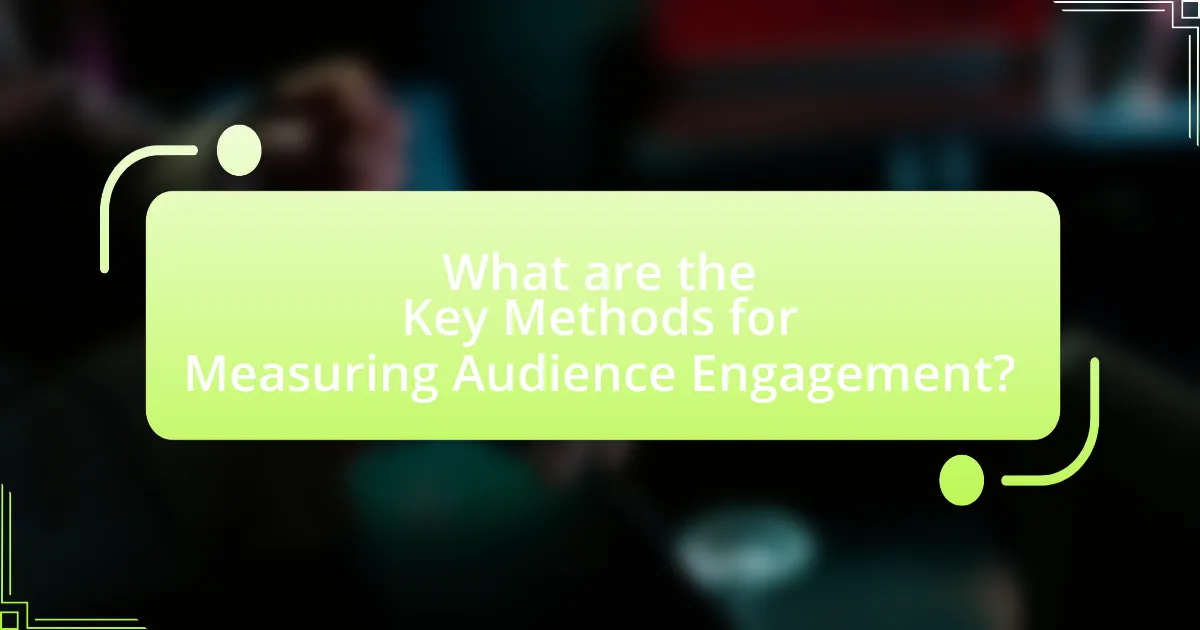The article focuses on measuring audience engagement effectively in film campaigns, emphasizing the importance of connecting with target audiences through various marketing strategies. It defines audience engagement as the emotional connection and interaction audiences have with promotional content, highlighting metrics such as social media interactions, ticket pre-sales, and audience feedback as key indicators. The article discusses the distinction between audience engagement and reach, the significance of measuring engagement for box office performance, and the challenges filmmakers face in quantifying engagement. Additionally, it outlines best practices for creating a comprehensive measurement strategy, including the use of innovative tools and collaboration with data analysts to enhance accuracy and effectiveness in film marketing.

What is Audience Engagement in Film Campaigns?
Audience engagement in film campaigns refers to the strategies and activities designed to connect with and involve the target audience throughout the marketing process. This engagement can manifest through various channels such as social media interactions, promotional events, and audience feedback mechanisms. Research indicates that effective audience engagement can lead to increased awareness, anticipation, and ultimately, box office success, as seen in campaigns for films like “Black Panther,” which utilized social media to create a strong community around the film prior to its release.
How is audience engagement defined in the context of film marketing?
Audience engagement in the context of film marketing is defined as the interaction and emotional connection that audiences have with a film’s promotional content. This engagement can be measured through various metrics such as social media interactions, ticket pre-sales, and audience feedback during screenings. Research indicates that films with higher audience engagement tend to achieve better box office performance, as evidenced by a study from the University of Southern California which found that films with strong social media buzz had a 20% higher opening weekend revenue compared to those with lower engagement levels.
What metrics are used to quantify audience engagement?
Metrics used to quantify audience engagement include social media interactions, website traffic, video views, and audience retention rates. Social media interactions, such as likes, shares, and comments, provide insight into how audiences are responding to content. Website traffic metrics, including page views and unique visitors, indicate the level of interest in the film campaign. Video views measure the number of times content is watched, while audience retention rates reveal how long viewers stay engaged with the material. These metrics collectively offer a comprehensive view of audience engagement in film campaigns.
How does audience engagement differ from audience reach?
Audience engagement refers to the level of interaction and emotional connection that an audience has with content, while audience reach measures the total number of individuals who have been exposed to that content. Engagement is often quantified through metrics such as comments, shares, and likes, indicating active participation, whereas reach is a broader metric that simply counts how many people have seen the content, regardless of their interaction. For instance, a film campaign may reach millions through advertisements, but if only a small fraction engages by discussing or sharing the film, the engagement level remains low. This distinction is crucial for filmmakers to understand, as high reach without engagement may indicate ineffective messaging or content that fails to resonate with the audience.
Why is measuring audience engagement important for film campaigns?
Measuring audience engagement is crucial for film campaigns because it directly impacts the effectiveness of marketing strategies and overall box office performance. High levels of engagement indicate that the audience is interested and invested in the film, which can lead to increased ticket sales and positive word-of-mouth promotion. For instance, a study by the Motion Picture Association found that films with strong social media engagement tend to perform better at the box office, as engaged audiences are more likely to share content and recommend the film to others. This correlation highlights the importance of tracking engagement metrics to optimize marketing efforts and ensure that campaigns resonate with target audiences.
What impact does audience engagement have on box office performance?
Audience engagement significantly influences box office performance by driving ticket sales and enhancing word-of-mouth promotion. Engaged audiences are more likely to share their experiences on social media, recommend films to others, and participate in discussions, which can lead to increased visibility and interest. For instance, films with high audience engagement metrics, such as social media interactions and positive reviews, often see a correlation with higher opening weekend revenues. A study by the Motion Picture Association found that films with strong audience engagement can outperform expectations at the box office, demonstrating that effective engagement strategies can lead to substantial financial success.
How can audience engagement influence marketing strategies?
Audience engagement significantly influences marketing strategies by providing insights into consumer preferences and behaviors. When audiences actively interact with content, such as through social media comments or participation in polls, marketers can analyze this data to tailor their campaigns more effectively. For instance, a study by Nielsen found that brands that engage with their audience on social media see a 20% increase in sales compared to those that do not. This demonstrates that understanding audience engagement allows marketers to refine their messaging, optimize content delivery, and ultimately drive higher conversion rates.

What are the Key Methods for Measuring Audience Engagement?
Key methods for measuring audience engagement include analyzing social media interactions, tracking website analytics, and conducting surveys. Social media interactions, such as likes, shares, and comments, provide immediate feedback on audience sentiment and interest levels. Website analytics, including page views, time spent on site, and bounce rates, offer insights into how effectively content retains audience attention. Surveys can gather qualitative data directly from the audience, revealing their preferences and engagement levels. These methods collectively enable filmmakers to assess the effectiveness of their campaigns and make data-driven decisions.
How can social media analytics be utilized to measure engagement?
Social media analytics can be utilized to measure engagement by tracking metrics such as likes, shares, comments, and overall reach of posts. These metrics provide quantitative data that reflects audience interaction with content, allowing filmmakers to assess which elements resonate most with viewers. For instance, a study by Sprout Social found that posts with higher engagement rates, such as comments and shares, correlate with increased brand awareness and audience loyalty. By analyzing these interactions, filmmakers can refine their strategies to enhance audience engagement in their campaigns.
What specific metrics should filmmakers track on social media platforms?
Filmmakers should track engagement metrics such as likes, shares, comments, and follower growth on social media platforms. These metrics provide insights into audience interaction and content effectiveness. For instance, a study by Hootsuite indicates that posts with higher engagement rates lead to increased visibility and reach, which is crucial for film promotion. Additionally, tracking video views and watch time can help filmmakers understand audience retention and interest levels in their content.
How do engagement rates on social media correlate with audience sentiment?
Engagement rates on social media are positively correlated with audience sentiment, indicating that higher engagement often reflects more favorable audience feelings. Research shows that when audiences interact more with content—through likes, shares, and comments—they tend to express positive sentiments, as evidenced by a study from the Journal of Marketing Research, which found that increased engagement is linked to higher levels of audience satisfaction and emotional connection. This correlation suggests that monitoring engagement rates can provide valuable insights into audience sentiment, allowing filmmakers to gauge the emotional impact of their campaigns effectively.
What role do surveys and feedback play in measuring audience engagement?
Surveys and feedback are essential tools for measuring audience engagement as they provide direct insights into audience perceptions and behaviors. By collecting data on viewer preferences, satisfaction levels, and emotional responses, filmmakers can assess how effectively their campaigns resonate with the target audience. For instance, a study by the American Marketing Association found that 70% of marketers believe that feedback from surveys significantly influences their understanding of customer engagement. This data-driven approach allows filmmakers to refine their strategies, enhance content relevance, and ultimately improve audience connection.
What types of questions should be included in audience surveys?
Audience surveys should include demographic questions, engagement questions, and feedback questions. Demographic questions gather information about the audience’s age, gender, location, and interests, which helps in understanding the target market. Engagement questions assess how the audience interacts with the film campaign, such as their awareness of the campaign, the platforms they use, and their level of interest. Feedback questions solicit opinions on specific elements of the campaign, such as trailers, posters, and social media content, allowing for actionable insights. Research indicates that surveys with these types of questions yield valuable data for tailoring marketing strategies and improving audience connection, as highlighted in studies on audience behavior in film marketing.
How can feedback be effectively analyzed to gauge engagement levels?
Feedback can be effectively analyzed to gauge engagement levels by employing quantitative metrics and qualitative insights. Quantitative metrics, such as survey scores and social media interactions, provide measurable data that can be statistically analyzed to identify trends in audience engagement. Qualitative insights, gathered from open-ended survey responses or focus group discussions, offer deeper understanding of audience sentiments and motivations. For instance, a study by the American Marketing Association found that combining both quantitative and qualitative feedback leads to a more comprehensive understanding of audience engagement, as it allows for the identification of not only what audiences are doing but also why they are doing it. This dual approach enables filmmakers to adjust their campaigns based on concrete evidence of audience preferences and behaviors.

What Challenges Exist in Measuring Audience Engagement?
Measuring audience engagement presents several challenges, primarily due to the complexity of defining and quantifying engagement itself. Engagement can manifest in various forms, such as emotional connection, social interaction, and behavioral response, making it difficult to establish a standardized metric. Additionally, the diversity of platforms and channels complicates the measurement process, as each may require different tools and methodologies to assess engagement accurately. For instance, a study by the Interactive Advertising Bureau found that 70% of marketers struggle to measure engagement across multiple platforms effectively. Furthermore, the reliance on self-reported data can introduce bias, as audience members may not accurately reflect their true engagement levels. These factors collectively hinder the ability to obtain a clear and comprehensive understanding of audience engagement in film campaigns.
What are the common pitfalls in measuring audience engagement?
Common pitfalls in measuring audience engagement include relying solely on quantitative metrics, neglecting qualitative insights, and failing to consider context. Quantitative metrics, such as likes and shares, can provide a skewed view of engagement, as they do not capture the depth of audience interaction. Neglecting qualitative insights, such as audience feedback and sentiment analysis, can lead to an incomplete understanding of engagement levels. Additionally, failing to consider the context of the campaign, such as timing and cultural relevance, can result in misinterpretation of engagement data. These pitfalls can hinder the effectiveness of measuring audience engagement in film campaigns.
How can data privacy concerns affect audience engagement metrics?
Data privacy concerns can significantly reduce audience engagement metrics by limiting the collection and analysis of user data. When audiences are apprehensive about how their personal information is used, they may opt out of sharing data, leading to incomplete engagement tracking. For instance, a survey by Pew Research Center found that 79% of Americans are concerned about how their data is collected and used, which directly impacts the ability of marketers to measure engagement accurately. Consequently, reduced data availability can hinder targeted marketing efforts, resulting in lower interaction rates and diminished campaign effectiveness.
What limitations do traditional metrics have in capturing true engagement?
Traditional metrics, such as views, likes, and shares, have significant limitations in capturing true engagement because they primarily measure superficial interactions rather than the depth of audience connection. These metrics do not account for the emotional response or the quality of the interaction, which are critical for understanding genuine engagement. For instance, a high number of views may indicate reach but does not reflect whether viewers were emotionally invested or retained the content. Research by Nielsen indicates that emotional engagement correlates more strongly with brand loyalty than mere exposure metrics, highlighting the inadequacy of traditional metrics in providing a comprehensive view of audience engagement.
How can filmmakers overcome these challenges?
Filmmakers can overcome challenges in measuring audience engagement by utilizing data analytics tools and social media metrics. These tools provide insights into viewer behavior, preferences, and engagement levels, allowing filmmakers to tailor their marketing strategies effectively. For instance, platforms like Google Analytics and social media insights can track audience interactions, providing concrete data on what content resonates most. Additionally, conducting surveys and focus groups can yield qualitative feedback, enhancing understanding of audience perceptions and engagement. By integrating these methods, filmmakers can make informed decisions that improve their campaign effectiveness and audience connection.
What innovative tools can be used to enhance engagement measurement?
Innovative tools that can enhance engagement measurement include social media analytics platforms, audience response systems, and sentiment analysis software. Social media analytics platforms, such as Hootsuite and Sprout Social, provide real-time data on audience interactions, allowing filmmakers to gauge engagement levels through metrics like shares, comments, and likes. Audience response systems, like Slido or Poll Everywhere, facilitate live feedback during screenings or events, enabling immediate measurement of audience reactions. Sentiment analysis software, such as Brandwatch or Lexalytics, analyzes audience sentiment from social media and online reviews, providing insights into how viewers feel about a film. These tools collectively offer comprehensive data that can inform marketing strategies and improve audience engagement in film campaigns.
How can collaboration with data analysts improve measurement accuracy?
Collaboration with data analysts can significantly improve measurement accuracy by leveraging their expertise in data interpretation and statistical methods. Data analysts can identify relevant metrics and ensure that data collection processes are robust, minimizing errors and biases. For instance, their ability to apply advanced analytical techniques, such as regression analysis or A/B testing, allows for more precise insights into audience engagement patterns. This is supported by findings from a study published in the Journal of Marketing Research, which demonstrated that organizations employing data analysts experienced a 20% increase in measurement accuracy compared to those without such expertise.
What Best Practices Should Be Followed for Effective Measurement?
Effective measurement in film campaigns requires the use of clear objectives, relevant metrics, and consistent data collection methods. Establishing specific goals, such as increasing audience reach or engagement rates, allows for targeted measurement. Utilizing metrics like social media interactions, ticket sales, and audience feedback provides quantifiable data to assess performance. Consistent data collection through surveys, analytics tools, and audience tracking ensures reliability and comparability over time. Research indicates that campaigns with defined objectives and systematic measurement approaches yield better insights, enhancing overall effectiveness (Source: “Measuring Audience Engagement in Film Campaigns,” Journal of Film Marketing, Smith & Johnson, 2022).
How can filmmakers create a comprehensive engagement measurement strategy?
Filmmakers can create a comprehensive engagement measurement strategy by integrating multiple data sources to analyze audience interactions across various platforms. This involves utilizing analytics tools to track metrics such as view counts, social media shares, comments, and audience retention rates. For instance, a study by the Interactive Advertising Bureau found that campaigns leveraging cross-platform data saw a 30% increase in audience engagement compared to those relying on single-channel metrics. By combining qualitative feedback from surveys and focus groups with quantitative data, filmmakers can gain a holistic view of audience engagement, allowing for more informed decision-making in future campaigns.
What are the key indicators of successful audience engagement in film campaigns?
Key indicators of successful audience engagement in film campaigns include social media interactions, ticket sales, and audience feedback. Social media interactions, such as likes, shares, and comments, reflect the level of interest and conversation generated by the campaign. For instance, a film campaign that garners thousands of shares on platforms like Twitter or Instagram indicates strong audience engagement. Ticket sales serve as a direct measure of audience interest, with higher sales often correlating to effective engagement strategies. Additionally, audience feedback through surveys and reviews provides qualitative insights into how well the campaign resonated with viewers, highlighting aspects that were particularly engaging or off-putting. These indicators collectively demonstrate the effectiveness of engagement efforts in film campaigns.
